Foundation design for climate change mitigation- robust details using no cement

Foundation design for Climate change mitigation – robust details using no cement
When we think of foundations for buildings and look to the building regulations to see what is recommended, cement is the most commonly accepted material. There are a few exceptions, but they are just that, a few. As cement wasn’t widely used in construction until the 1920s, what was going on underground before then? Barbara Jones, Director at Straw Works, founder of the School of Natural Building and author of ‘Building with Strawbales’ discusses a few alternatives to cement-based foundations.
Introduction
It is important to recognise that cement-free foundations are not a new idea. Much of the world’s housing stock have cement-free foundations, as are many homes in the UK. Cement was invented in 1824 but wasn’t much used in construction till about 1920. If we look at buildings dating from before 1920, we can see natural foundation solutions, typically constructed with stone and brick with lime mortars, sometimes with gravel trenches. Another important aspect of cement-free foundations is that they are flexible – and this means they are durable and will stand the test of time as earth movements cause changes, but not structural changes.
Stone foundations with no mortar
Many traditional vernacular houses are built with only stone, or smaller stone (gravel) beneath them. Cob houses, in particular, are likely to have this type of foundation. As for all foundations, the topsoil must be removed and the stone laid down on top of good bearing soil, which may be just under the topsoil, but may be deeper. Gravel, since it cannot support its own shape like stone, must be contained within soil that can, usually in modern times with a fabric liner; therefore, it is not suitable for all soil types. An example of this is when we used a gravel trench with a brick, lime, and foamglass plinth above for the foundations of the Council houses in North Kesteven in 2009.
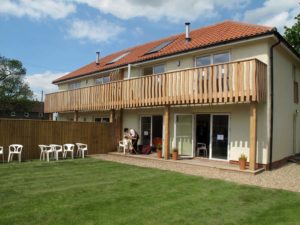
Gravel trenches and Frank Lloyd Wright
Frank Lloyd Wright, an architect working in the USA in the early 20th Century, and known for his love of nature, popularised the traditional method of building foundations using a gravel trench (albeit with cement blocks or a slab on top). He drew on traditional methods to create more simple modern buildings, often opting for a gravel trench using small stone instead of wet cement to support the weight of the building.
Brick/stone and lime plinths with foamglass
Strawbale houses, like Cob houses, require a plinth or stem wall above ground to protect the more vulnerable wall material from splashback. Using brick/stone with lime mortar as an outer skin and foamglass blocks as an inner skin, with the loadbearing core filled with foamglass chunks is a great solution and gives a wall with a U value of 0.17W/m2K. This is a great modern design for situations where aesthetics requires something more traditional in appearance. The buildings can be laid on gravel trenches, or brick (engineering below ground) or stone laid with lime mortar.
As a roofer, I came across foamglass blocks a long time ago, primarily used as a horizontal insulating material. I asked the company manufacturing them if they could be used as a loadbearing material. Only one type can, the T4 (now called T4 plus). From there I designed the first foundations using these blocks, again for the North Kesteven council houses in 2009. I needed a well-insulated but natural solution for plinth walls and this sufficed.
Ram-filled car tyre foundations
By 1994 I was an experienced builder with my own construction company. I was traveling, looking for alternative building solutions that were better for the environment. In Arizona, I came across some off-grid housing types which combined natural materials with upcycled materials called Earthships. Everyone I talked to said ‘great idea but too much hard and repetitive work’ (I file this under my ‘no fun building’ category) however, I thought ‘wouldn’t their use of rammed earth tyres be great for foundations?’ so I started experimenting when I got back to the UK. I was designing natural buildings and building my first foundations with rammed earth-filled car tyres. This worked ok but it was hard work. The Building Inspectors were unsure about it and asked, ‘how can you prove that one shovelful of earth is identical to another?’ Nevertheless, the design was passed by Calderdale Planning and Building Control for a sauna in Hebden Bridge back in 1996 – unfortunately, this was never built. The first fully legally approved building was for the Clow Beck Trust at Croft, North Yorkshire in 2002. Richmondshire council insisted on the use of crushed dolomite and onsite load testing. This passed easily and the building (a dormitory for a school) was built, with course participants building the tyres under my supervision.
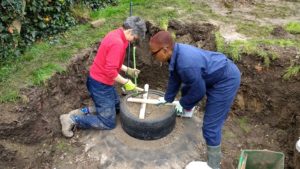
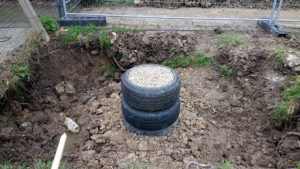
Since then I have refined the fill used to ram the tyres. Initially, we had to use MOT type 1 fill, as engineers insisted. This is a standard type of gravel used for roads hence Ministry of Transport (MOT) that has been extensively tested. It is a hard job to ram-fill tyres with this and it needs to be compacted severely every 150mm and packed tightly under the rim of the tyres. I had found the ideal solution: pea shingle, or 10mm draining gravel. As the engineers I spoke with were unsure of this type of gravel and couldn’t produce the data modeling, I didn’t always win the argument that it would be suitable. I persisted with this gravel type as knew it was a lot easier to use, and my practical experience told me it was just as effective as using MOT type 1. It can be poured like water and it finds its own level. Like concrete, it needs a bit of shaking and the only real compaction happens at the end making sure it is rammed tight under the rim of the tyre. Additionally, it is far less processed and usually cheaper (unless you happen to go for the decorative type used on driveways). This means that a tyre can be rammed extremely quickly by an experienced person and pretty fast by new course participants. When we did on-site testing for a major project in London in 2018, this method of ram filling the tyres satisfied the engineers, and I was proven correct!
As a designer and builder committed to using natural materials wherever possible, I did have to think about using car tyres. My thinking is that they are a waste product, very difficult to get rid of. They are also extremely cost-effective and can be the make or break decision for community groups and self-builders. Through the use of up-cycling car tyres for use in foundations, two large community build projects saved about £100,000 each by designing foundations in this way.
Stone filled gabions
This is an alternative to the earth rammed car tyres. Some issues with this method are the wire of the gabions has nowhere near the life of a steel rimmed car tyre covered in rubber. It is harder to lay the stone carefully in the wire basket to avoid settlement later and It is more expensive.
Timber foundations
Many traditional houses have timber foundations. Think Tudor, think of Venice, or parts of Winchester Cathedral. Modern houses can have them too. I’ve designed community centres using old telegraph poles, and an artist’s studio near Turriff with timber posts on top of flat stones. All legal and approved.
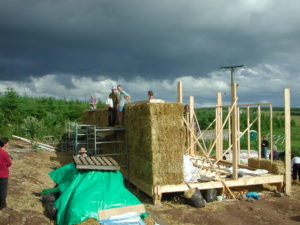
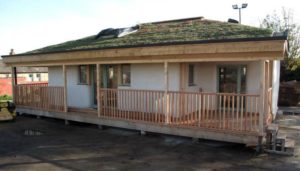
In conclusion
There are several permutations of cement-free foundations, using different sorts of materials, which should suit all ground conditions and aesthetics. We can be informed by our ancestors, the master builders, who built to last, and be inspired by the Romans who’s great bridges and monuments were built with stone brick and lime, and we can think outside the box for natural solutions that don’t add to the negative effects of climate change. That’s the challenge. Are you up for it?






